Japan Tradition: Hadaka Matsuri
Hadaka Matsuri
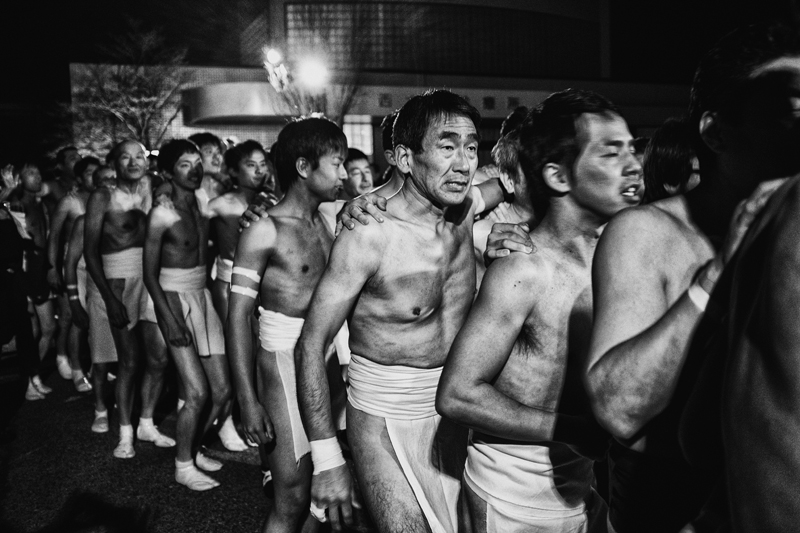
Sebbene oggi giorno la nudità non rappresenti quasi più una vergogna, da questa parte del mondo e non solo, essa rientra spesso nella categoria di quegli argomenti comunemente considerati pruriginosi.
La nudità incuriosisce, talvolta ci turba, e senz’altro stuzzica le fantasie di ognuno di noi.
Il Paese del Sol Levante è terra ricca di abitudini e tradizioni che spesso entrano in contrasto tra di loro. Prendiamo per esempio l’ossessione per le buone maniere, l’estrema riservatezza, il gran senso del pudore e i quartieri dediti alle trasgressioni notturne e ai divertimenti senza fine. Tuttavia in questo paese trovano posto anche i festival dedicati alla nudità. Non c’è migliore occasione per “mettere a nudo se stessi”, se non durante l’Hadaka Matsuri.
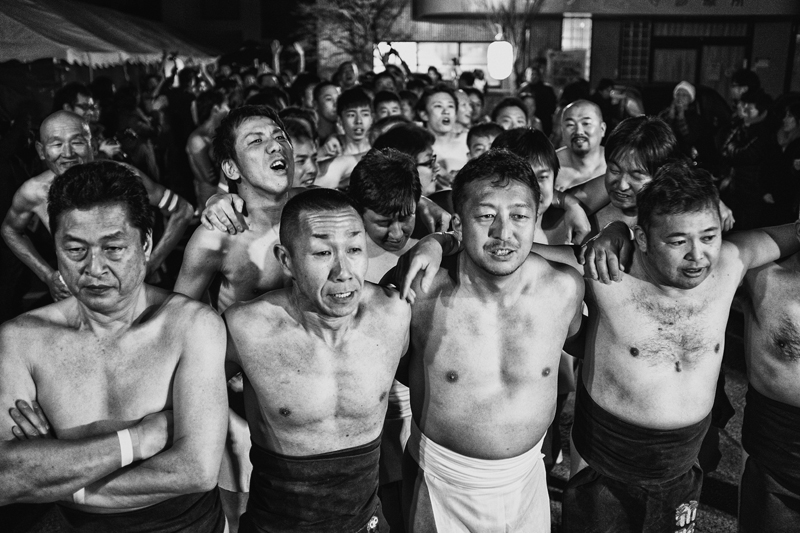
Prima di entrare nel vivo di questa celebrazione, farei un passo indietro. Nella lingua giapponese, il termine matsuri indica una festa tradizionale. Questo nella loro cultura coincide con un evento che attira nelle strade e nei parchi centinaia di persone.
Le Origini
Molti di questi festival hanno avuto origine dalle feste tradizionali cinesi. Esse tuttavia sono andate scomparendo con gli anni, mischiandosi o venendo rimpiazzate dalle tipiche usanze giapponesi. Infatti in Giappone, il concetto di festa o celebrazione, deriva dal profondo legame che questo popolo ha con la natura, riconducibile anche alla religione tradizionale del Paese, lo Shintoismo.
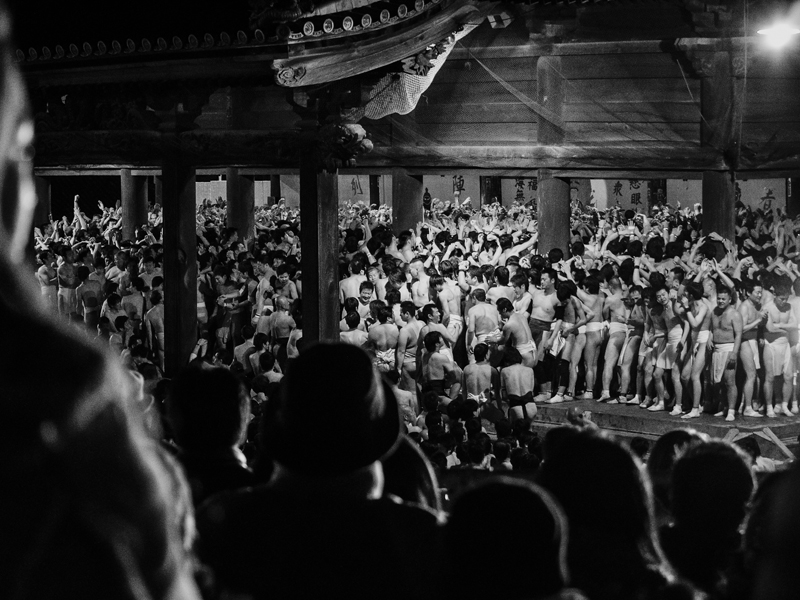
L’Hadaka Matsuri letteralmente significa “festa dell’uomo nudo”. Durante questa celebrazione i circa 9.000 partecipanti, solamente uomini, indossano unicamente il perizoma tradizionale giapponese, il fundoshi, e per chi lo desidera, anche il kimono. Ma non solo, tra i partecipanti, c’è chi sceglie anche di non indossare nulla.
Questa festa ha luogo in diverse zone del Giappone. La più importante è quella di Okayama (sede originaria dell’evento), sull’isola di Honshu. Essa si svolge nel Tempio Saidai-ji, infatti il nome completo della festa è “Saidaiji Eyo Hadaka Matsuri”. Trattandosi di un evento di tipo religioso è assolutamente vietato bere o portare alcool. Inoltre, gli uomini che hanno dei tatuaggi possono partecipare, ma solo a patto che li coprano con del nastro.
L’Hadaka Matsuri ha origini lontanissime. Si dice che risalga al 767 d.C., quando i fedeli gareggiavano per ricevere talismani fatti di carta, i go-o, gettati da un sacerdote.
Hadaka Matsuri e la nudità
Secondo alcune testimonianze, si dice che coloro che riuscivano ad ottenere questi talismani avrebbero goduto di un anno di fortuna.
Inoltre, la credenza collettiva vedeva la nudità in grado di assorbire mali e sfortune. Infatti colui che riusciva ad ottenere il talismano, veniva proclamato Uomo Nudo o Uomo dello Spirito (shin-otoko). Tutti coloro che volevano liberarsi della propria sfortuna cercavano di toccarlo.
Ma ancora oggi, essendo in tantissimi uomini a prendere parte alla gara, non è affatto semplice per loro riuscire a “toccare” il più fortunato. Anche per i partecipanti più assidui possono essere necessari molti anni prima di riuscire ad avere un contatto con il suddetto.
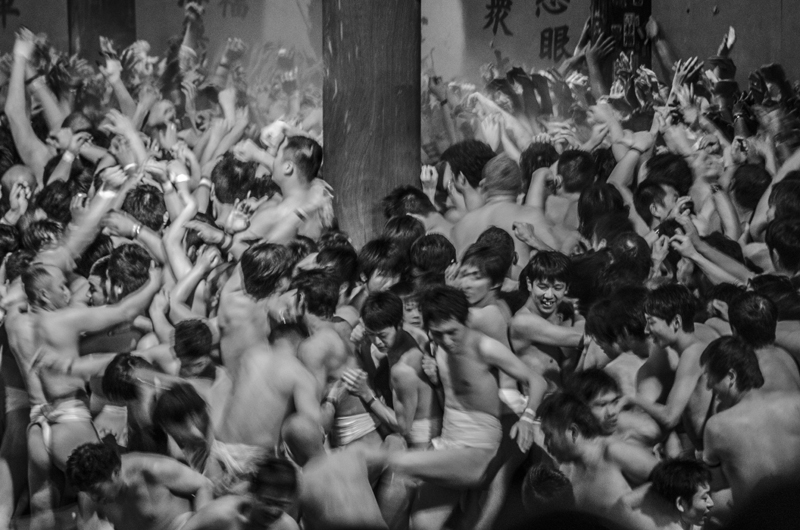
Con il passare del tempo, i sacerdoti si resero conto che i go-o, essendo realizzati in carta, avevano vita breve. Infatti, molto spesso finivano per essere distrutti proprio durante la calca per accaparrarne uno. Successivamente furono sostituiti con dei bastoni di legno usati ancora oggi e preparati dagli stessi sacerdoti con l’aiuto di strumenti manuali.
Ed ecco come la nudità si tramuta in sacra tradizione.
La tradizione
Dopo aver vissuto alcuni giorni in isolamento in veglia e in preghiera, i giovani partecipanti con indosso solo il fundoshi, si dirigono verso il Tempio. Essi corrono, mentre vengono investiti da getti di acqua ghiacciata. Giunti nel Tempio, devono riuscire ad afferrare uno dei bastoni di legno, gli shingi. Questi vengono gettati dai sacerdoti che si trovano nella parte alta del Tempio. Alle ore 22:00, per rendere la prova ancora più ardua e di difficile realizzazione, questi talismani vengono lanciati a luci spente o quasi. Una volta agguantato il bastone, il primo che riesce ad infilarlo in posizione verticale in una scatola di legno colma di riso, viene proclamato shin-otoko. Il vincitore viene benedetto con un anno di felicità e fortuna, oltre che ottenere un premio in denaro.
Oltre agli shingi, i sacerdoti gettano anche 100 rami di salice, e chiunque riesca ad afferrarli avrà fortuna nell’anno futuro.
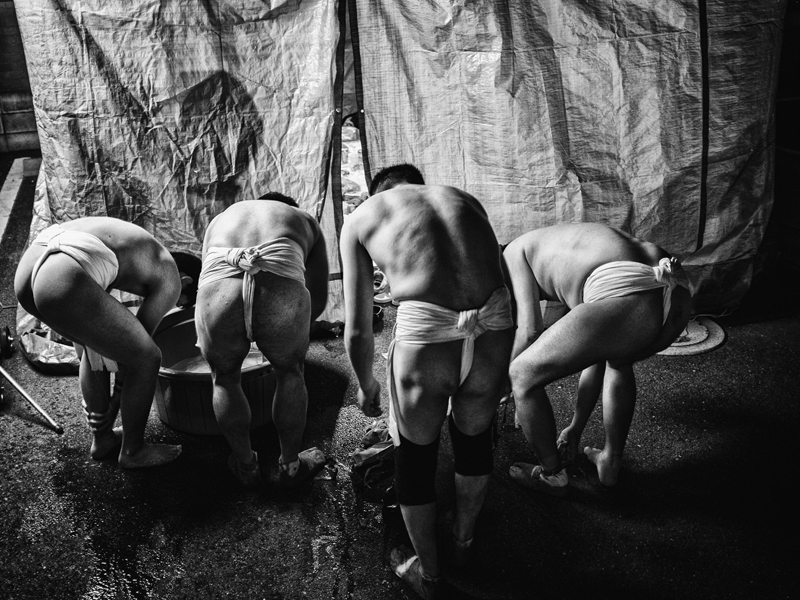
Meno fortunato, succede anche che durante la calca avvengano incidenti. Nel migliore dei casi si tratta “solamente” di ematomi, nasi e labbra rotti. È per questo motivo che i sacerdoti chiedono sempre di annotare sul fundoshi (o su un pezzetto di carta da inserire al suo interno) tutte le informazioni utili, come ad esempio: nome, cognome, indirizzo e gruppo sanguigno.
Fotografo : Kurt Gledhill
Condividi:
- Fai clic per condividere su Facebook (Si apre in una nuova finestra)
- Fai clic qui per condividere su Twitter (Si apre in una nuova finestra)
- Fai clic qui per condividere su Tumblr (Si apre in una nuova finestra)
- Fai clic qui per condividere su Pinterest (Si apre in una nuova finestra)
- Fai clic per condividere su Telegram (Si apre in una nuova finestra)
- Fai clic per condividere su WhatsApp (Si apre in una nuova finestra)
- Fai clic qui per condividere su Reddit (Si apre in una nuova finestra)
- Fai clic qui per stampare (Si apre in una nuova finestra)






